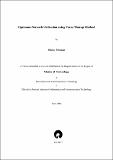Please use this identifier to cite or link to this item:
http://drsr.daiict.ac.in//handle/123456789/77Full metadata record
| DC Field | Value | Language |
|---|---|---|
| dc.contributor.advisor | Jotwani, Naresh D. | |
| dc.contributor.author | Thomas, Shabu | |
| dc.date.accessioned | 2017-06-10T14:36:55Z | |
| dc.date.available | 2017-06-10T14:36:55Z | |
| dc.date.issued | 2005 | |
| dc.identifier.citation | Thomas, Shabu (2005). Optimum network utilization using fortz-thorup method. Dhirubhai Ambani Institute of Information and Communication Technology, ix, 61 p. (Acc.No: T00040) | |
| dc.identifier.uri | http://drsr.daiict.ac.in/handle/123456789/77 | |
| dc.description.abstract | Internet traffic has increased over the previous years and there has been a change in traffic requirements due to the emergence of new applications and services. This makes it more challenging for the network service providers to handle congestion and provide Quality of Service guarantees. Therefore, a good management and control over the functioning of a network becomes necessary. A network service provider’s objective is then to have appropriate policies and mechanisms in place that ensures optimum functioning and utilization of the network such that the guaranteed service agreement with the users of the network is not violated. This thesis work specifically focuses on increasing the utilization of a network by making use of existing capacity to carry more traffic. In this regard we propose a simple admission control scheme within the model of Fortz Thorup Method (FT Method), which avoids congestion while accommodating a new demand request. This admission control scheme tries to admit the new demand without requiring any reconfiguration of the OSPF weights thus speeding up the decision time to admit a new demand. It was found that when the network was operating in a state close to congestion as defined by the FT Method, many links were still operating below their existing capacities. New demands were created between pair of nodes, which were 1-hop, 2-hop, 3-hop and 4-hop apart and tests were conducted to check whether their admission caused congestion or not. We found out that as the hop distance between the node-pair increased, less and less number of admission request satisfied the admission control criteria. It was also observed that, in almost all test cases, admission requests were rejected not because their acceptance caused the congestion criteria to be violated but that there was already a link in the path followed by the new request which was violating the criteria. | |
| dc.publisher | Dhirubhai Ambani Institute of Information and Communication Technology | |
| dc.subject | Fortz-thorup method | |
| dc.subject | Communication networks - Traffic | |
| dc.subject | Communication networks | |
| dc.subject | Data transmission modes | |
| dc.subject | Network utilization | |
| dc.subject | Network service provider | |
| dc.classification.ddc | 621.3821 THO | |
| dc.title | Optimum network utilization using fortz-thorup method | |
| dc.type | Dissertation | |
| dc.degree | M. Tech | |
| dc.student.id | 200311013 | |
| dc.accession.number | T00040 | |
| Appears in Collections: | M Tech Dissertations | |
Files in This Item:
| File | Description | Size | Format | |
|---|---|---|---|---|
| 200311013.pdf Restricted Access | 417.33 kB | Adobe PDF |  View/Open Request a copy |
Items in DSpace are protected by copyright, with all rights reserved, unless otherwise indicated.
